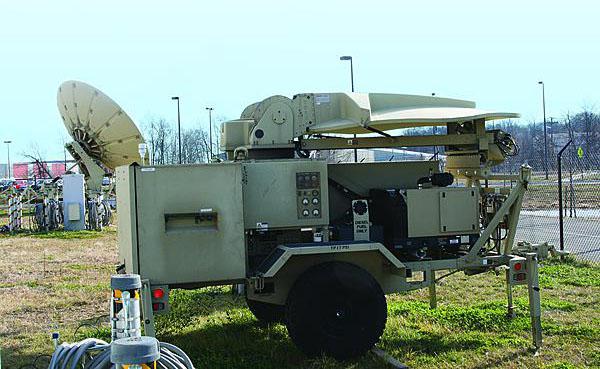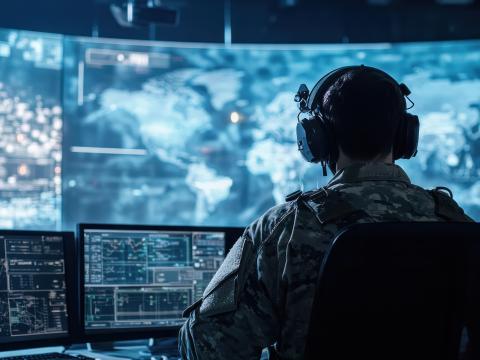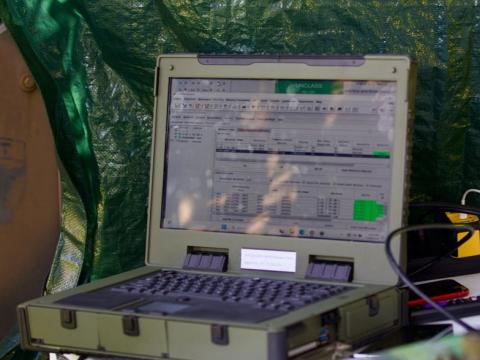Communications Labs JOIN Forces Remotely
The whole becomes greater than the sum of the parts in a networked software engineering realm.
A network built after its major move to a new base is allowing the U.S. Army Communications-Electronics Command to link diverse communications systems into an overarching network. This enables capabilities ranging from debugging software updates before they are sent to the front to a multinational exercise for validating operational activities.
When the Communications-Electronics Command (CECOM) relocated from Fort Monmouth, New Jersey, to Aberdeen Proving Ground, Maryland, under the Base Closure and Realignment program (BRAC), it used the opportunity to consolidate capabilities and build new facilities from the ground up that would allow the command to take advantage of the latest technologies. Among these facilities is the Joint On-demand Interoperability Network, or JOIN. This network connects with other laboratories and communications facilities, including some in theater, to share resources and solve problems by using all of their capabilities.
The network has existed in some form for more than two decades. Today’s JOIN community includes research, development, testing and evaluation as well as life-cycle support. JOIN serves as the nexus for these diverse elements. It provides two capabilities: services and interconnectivity as a technical hub.
John Kahler, chief of JOIN, allows that the network was established to integrate the entire command, control, communications, computers, intelligence, surveillance and reconnaissance (C4ISR) community and to provide a technical hub so that organizations could exploit each other’s resources as well as work in “a collaborative, common operating environment.” Participants can conduct research, development, testing and engineering along with life-cycle support.
He relates that the BRAC transition gave JOIN the chance to centralize many of the program manager stovepipe requirements that previously existed at Fort Monmouth. CECOM was able to add CENTRIXS-Korea and CENTRIXS-ISAF to boost its coalition capabilities. CENTRIXS-Japan is next on the list, he adds.
Kahler explains that many organizations already have point-to-point communications capabilities, so JOIN serves to centralize those communications. JOIN’s distributed test environment of networked resources carries out risk reduction, integration, assessment and certification. This includes both the elements at Aberdeen Proving Ground and remote assets. He notes that managing key communications resources centrally reduces network risks and increases cybersecurity.
“It’s lab-based risk reduction activities,” Kahler explains. “We can do all of that here before [systems] go into events such as NIE [Network Integrated Evaluation]. We can do the risk assessment and knock out those bugs here—locally.”
This allows organizations to prepare for exercises such as the NIE as well as other coalition exercises. Kahler points out that it saves resources by not needing to deploy large groups of people or systems over great distances.
Kahler notes that software engineering for field updates is at the core of CECOM’s Software Engineering Center. It ensures that the software updates sent to the field work properly the moment they are installed. JOIN allows that work to be subjected to laboratory-based risk reduction before systems are upgraded or even evaluated in an exercise.
Tactical communications resources, including satellite services, enable the center to reach out worldwide. Fiber cables link local laboratories with the center, which allows connectivity with virtually anywhere in the C4ISR community. This allows laboratories in diverse locations to share the same capabilities offered at Aberdeen.
“As we moved the C4ISR community here into one campus, we could tie them together and connect them to benefit by using others’ capabilities,” Kahler relates.
A step teleport site serves as a strategic/tactical entry point that is similar to worldwide Defense Department link points. This allows the center to replicate field activities by warfighters. “That is important because we can tie systems that are under development [and] the life-cycle support together,” he says.
JOIN supports U.S. Forces Korea from its CECOM location. A direct connection with Korea enables JOIN experts to help solve interoperability issues a hemisphere away. Another activity has JOIN working directly with the Defense Information Systems Agency (DISA). Before tactical systems deployed, they were changing into new types of information systems based on Internet protocol. With the current infrastructure making that transition, JOIN helps ensure that tactical systems will work when they interface. DISA has given JOIN a connection to that new infrastructure. “It’s a great relationship,” Kahler states.
Support to the warfighter is a key mission area. A commander who is preparing for deployment can reach back to JOIN through its tactical communications resources. That commander in turn would be connected into the internal JOIN laboratory resources or with other laboratories in the C4ISR community. If that commander is having communications problems, JOIN can link all the laboratory resources to find an appropriate solution, and this effort would be managed centrally.
This ability extends beyond the Army. Kahler reports that JOIN also works with the U.S. Marine Corps through the Army-Marine Corps interoperability board. When the Army deploys, it usually deploys with the Marine Corps, he notes, so the two services are using JOIN to work through their interoperability issues. Ultimately, JOIN may tie the NIE to that process, he offers.
The core of the laboratory comprises several networks—the Secret Internet Protocol Router Network (SIPRNet), the Nonsecure Internet Protocol Router Network (NIPRNet), the Combined Federated Battle Laboratories Network and the Defense Research Engineering Network along with coalition networks such as CENTRIXS-ISAF and CENTRIXS-Korea. When a member of the C4ISR laboratory needs access to one of them, that person need only request a connection, and JOIN will take care of all the logistics, Kahler says.
Remote partners include Fort Huachuca, Fort Leavenworth, Fort Gordon, Fort Bliss, Fort Hood, Fort Sill, Redstone Arsenal, White Sands Missile Range and Camp Pendleton. Other U.S. government organizations work with JOIN. These include military-oriented groups such as Yuma Proving Ground, the Edgewood Chemical Biological Center and the U.S. Navy at Dahlgren along with the Federal Emergency Management Agency (FEMA) and NASA.
These partnerships can be exploited a number of ways. Kahler describes how Naval Air Engineering Station Lakehurst has airframes that CECOM lacks. The intelligence community can use those Lakehurst airframes through JOIN for testing via remote connections.
Some intelligence organizations use JOIN to collect information live from the theater, he reports. This information may be as mundane as which guns have missed their targets, after which adjustments can be made to correct their aim.
“The benefits to the community are: it’s here, it’s centrally managed and it’s available on demand,” Kahler declares.
Most of the challenges that JOIN must address fall into two categories: information assurance and political issues. “Political is probably the worst,” Kahler offers. “Everybody has their rice bowl they try to protect. We try to overcome that and be a neutral body; just try to work together in a collaborative environment. It’s working most of the time,” he says.
JOIN also serves as the center of the Joint User Interoperability Communications Exercise, or JUICE. The annual event, co-sponsored by the U.S. Strategic Command, is built around the concept of a joint task force that is centralized at JOIN. Its activities focus on joint expeditionary forces, coalition partners, homeland security, federal agencies, Defense Department support to civil authorities and industry partners.
Other components participating in the exercise need not participate on site, Kahler notes. They can connect remotely from wherever they are located using their own organic communications.
He continues that JUICE is a capstone event for activities that CECOM has done over the year and for gaps that have been identified by combatant commands, services and agencies. Addressing these gaps involves bringing in industry partners to determine if their technologies and capabilities can solve those challenges. Kahler relates that, in one example, companies addressed hybrid power issues by demonstrating three different systems that were deployed in Afghanistan and Haiti. In another case, FEMA shut down its Internet inside the Washington Beltway and then asked JUICE to provide backup.
JUICE features a joint network control center that is run by active-duty personnel, not civilians. While these soldiers control the communications resources, they do not control what the elements do, Kahler explains, as JUICE is not designed to be a demonstration. The control center maintains the flexibility to validate joint interoperability; train; validate operational readiness; develop tactics, techniques and procedures (TTPs); and integrate joint, federal coalition, national and civil defense systems into one exercise.
Active-duty military at all locations engage in training while part of the event. JUICE also can certify systems while they are in the exercise, which avoids the need to deploy personnel and equipment. And, JUICE can perform pre-assessment for the NIE.
“Some of the vendors and industry partners [participating in NIE] never have been in anything like this before,” Kahler relates. “It’s very daunting for them to even consider going into a tactical environment, which is what they do when they go to NIE. So they’ll come here first, they can pre-assess and try to re-create the equipment string and the network they are going to be in when they get out to NIE, and we can really take a closer look at their system. They can take a closer look at what they’re going to be involved in before they get there.”
He continues that JUICE allows CECOM to examine new and emerging technologies that address existing issues. Some of these are cross-bridging solutions that connect coalition partners to U.S. forces, for example. Information assurance issues can be addressed as well.
International participation can lead to innovative approaches. Last year, Sweden fired rounds from Norway based on a call for fire that originated in CECOM.
“Other organizations were taking a closer look at what we were doing [at JUICE] last year because we used operational networks,” Kahler reports.
He notes that participants in last year’s event learned a great deal about cyberdefense, so these activities are being expanded for the 2013 event. JUICE 2013 also will validate a TTP for the cyberdefense activities of the joint task force, which Kahler says is unprecedented. This effort will include close involvement with the Army-Marine Corps interoperability board, which is seeking this TTP.






Comments